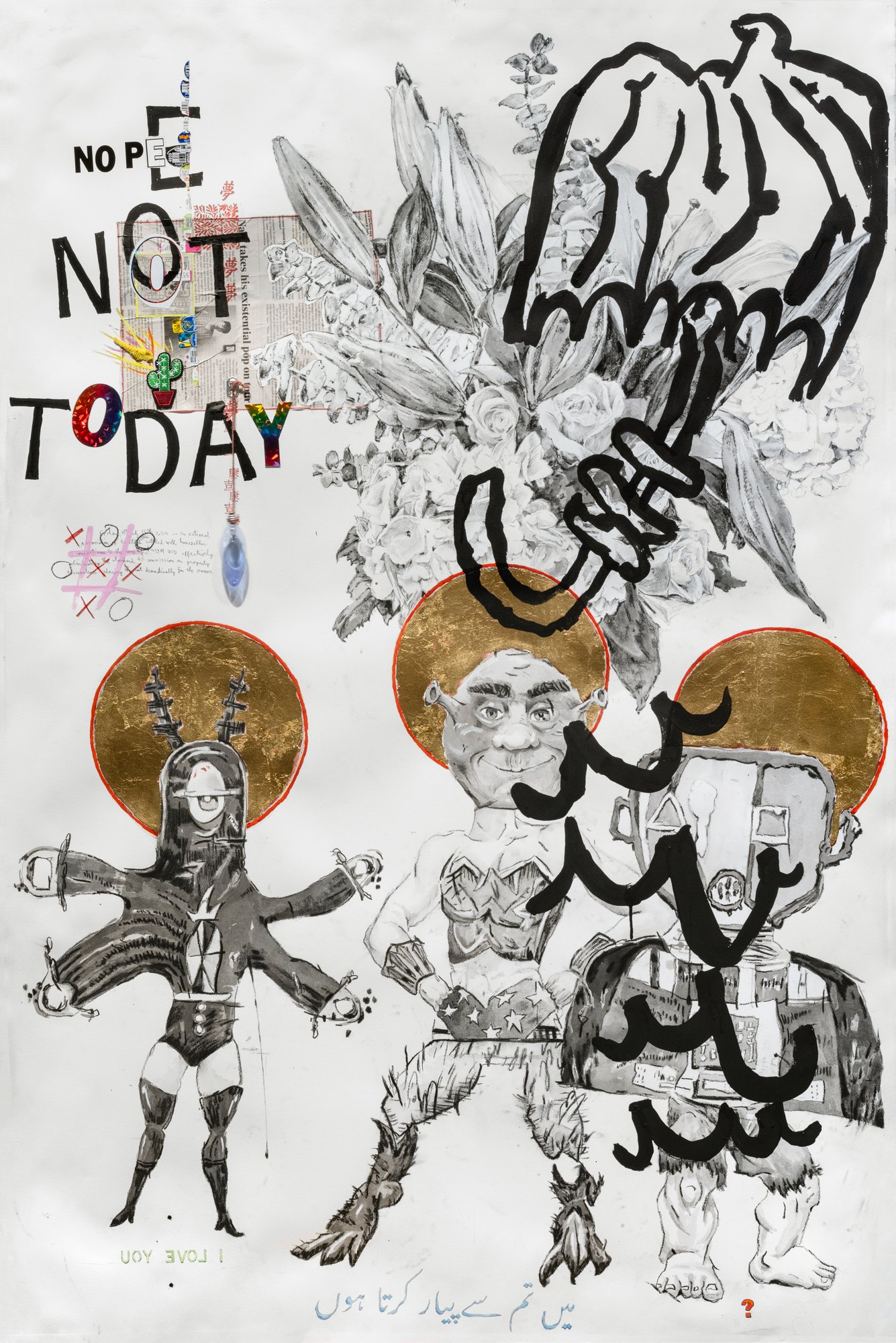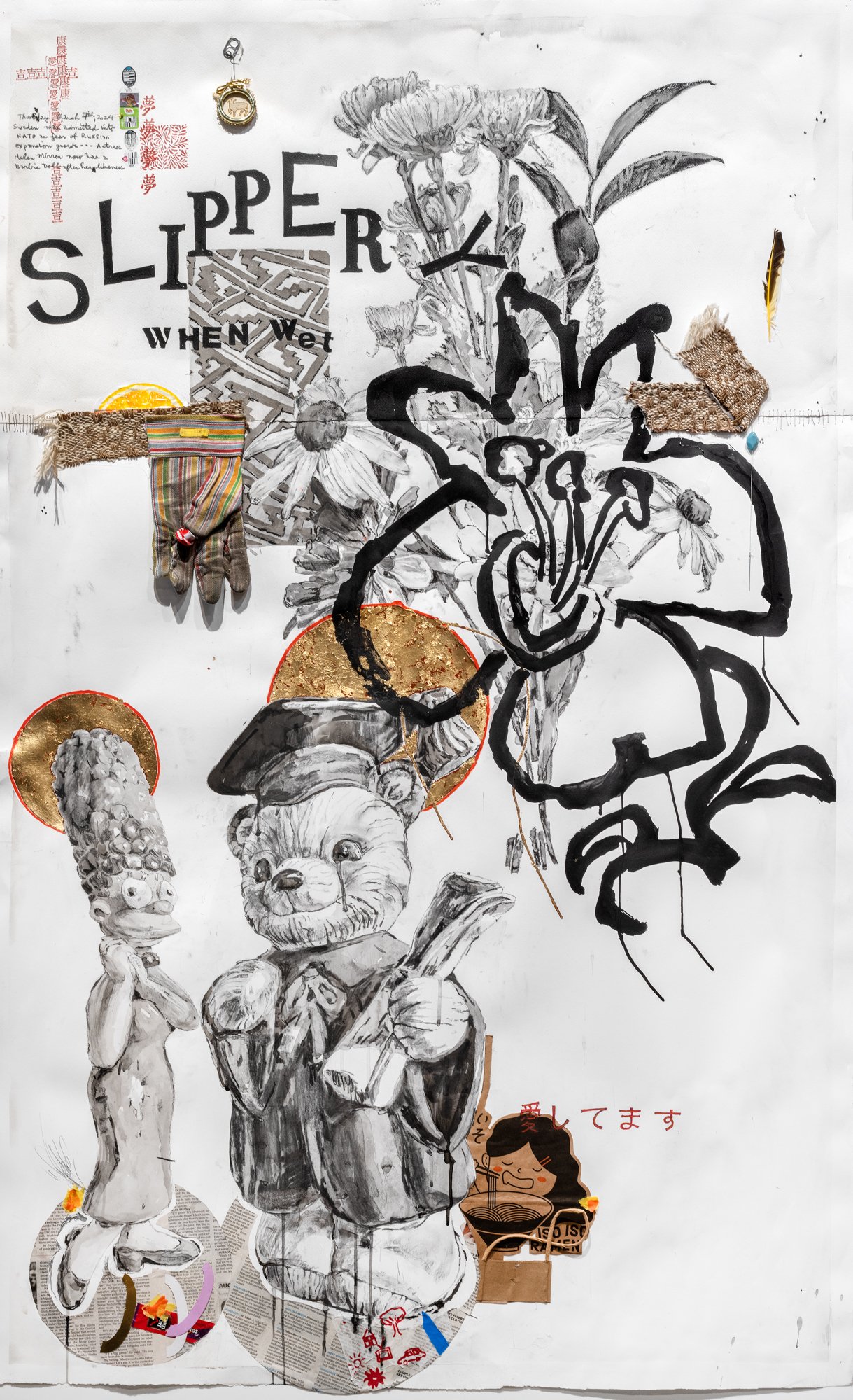Nate Hester - an emerging mid-career, transdisciplinary, diaristic artist from North Carolina in the United States, exhibited widely two decades ago—resurfacing recently at Satellite Art Show concurrent to Art Basel Miami in December 2023 with subsequent exhibits in New York, Los Angeles and Tokyo. Hester’s unapologetic pop-punk, Southern Gothic, magic realism works are included in the permanent collections of the Fogg Art Museum at Harvard University, the Allen Memorial Art Gallery at Oberlin College, the Newark Public Library, and the New York Public Library. In the upcoming year, Hester will be in residence at Residency Unlimited (Brooklyn NY), Kolaj Institute (New Orleans LA), Studio Kura (Fukoka, Japan), the Virginia Center for the Creative Arts (Amherst VA) and Chateau Orqueveaux (Troyes, France). He loves fruit pies, the trickle of water over rocks along a creek in any deciduous forest and the memories of his 15 year old son as a young boy.
Hester’s absurd and reverential vision explores the charming if disquieting incongruities of the places, communities and bodies to which we all yearn to belong – in particular, the landscape of the modern home. In his most recent topo-psychoanalytic, “In Search of Lost Time,” toys, flowers, imaginary avatars, human figures, found objects, and pop culture aphorisms cavort in almost—but never fully— comprehensible ways. The language of maximalist collage is invoked to address the fragmentation and inclusive reintegration of modern living. Hester asserts: “I don’t know about y’all, but my life is a hot-mess-dumpster-fire. Like that Leonard Cohen song about the cracks letting the light in, the beauty for me is how I manage to stitch all the ripped-toshreds pieces back together again.” Here, in the face of the predatory aggression of the adult world in the forms of advanced free market capitalism, neocolonialism and patriarchy, intimate sensuality and soulful tenderness prevail and proclaim that everything belongs to everything. In the face of sadness and “saudade” - the Portuguese concept of nostalgia for the future, Hester’s unapologetic pop-punk, Southern Gothic, magic realism calls forth the curiosity and playfulness of his own inner child, with the explicit hope that it invites audiences to connect to their own native and enduring bliss.
What drives you?
I exist to expand the scope of human empathy through the expression of the silly sacred. I care about and am driven by meaningful relationships. The great thing about drawing from life or observational rendering is that it is always about harmonizing relationships. The way to achieve the correct proportions or tonal gradations is by seeing how things fit together. I like when the right things fit together in the right way at the right time. In essence, I like creating harmony surprising harmony.
Where do you get your inspiration?
I get inspired by looking at Titian’s Andromeda in the Wallace Collection in London or graffiti in the banlieue train track corridors of Paris, hugging people that I love, reading Wallace Stevens’ “The Idea of Order at Key West,” going out to dinner with raucous friends, hiking to the top of mountains, diving into the ocean, dancing to funk beats and singing outlaw country music at the top of lungs.
If I could have a group exhibit with anyone in the world currently alive, I would want to call it “Sidewalk Shamanism: Contemporary Surrealist. Hip-Hop Protest Textiles” and feature the work of Yinka Shinobare from Nigeria, Nick Cave from Chicago, Joo Young Choi from Houston, Texas and Melissa Monroe from Portland, Oregon.
What is your life quote/motto?
In Voltaire’s Candide, the naïve religious cleric, Pangloss, is a foil for the author to criticize organized religion at the time of the Enlightenment. Pangloss routinely says, “Le paradis terrestre est ou je suis.” This translates as “earthly paradise is wherever I happen to find myself.” While this was used in mockery and derision as Pangloss would exclaim this in the face of experiencing real human atrocities, I have reappropriated it for my own brand of earnest optimism and devious delight. In other words, my life motto is “bloom where planted.” No matter what forces try to pave over you and block out your sunlight, keep pushing your leaves up through the cracks in the sidewalk.
What jobs have you done other than being an artist?
I have been an interfaith hospital chaplain as well as a sports marketer for a cybersecurity company.
Website: https://www.thenatehesterstudio.com
Instagram: https://www.instagram.com/nate_is_pretty_sketchy/











